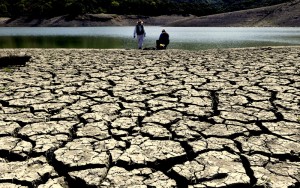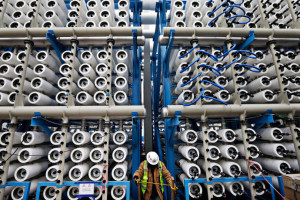Saturday, July 25th, 2015
Maude Barlow , - The Nation
Stephan:
Yet more on water, and its power to create a nation's destiny.

Cracks in the dry bed of the Stevens Creek Reservoir in Cupertino, Calif.
Credit: Marcio Jose Sanchez/AP
The United Nations reports that we have 15 years to avert a full-blown water crisis and that, by 2030, demand for water will outstrip supply by 40 percent. Five hundred renowned scientists brought together by UN Secretary-General Ban Ki-moon said that our collective abuse of water has caused the earth to enter a “new geologic age,” a “planetary transformation” akin to the retreat of the glaciers more than 11,000 years ago. Already, they reported, a majority of the world’s population lives within a 30-mile radius of water sources that are badly stressed or running out.
For a long time, we in the Global North, especially North America and Europe, have seen the growing water crisis as an issue of the Global South. Certainly, the grim UN statistics on those without access to water and sanitation have referred mostly to […]
1 Comment
Derek Thompson, - Atlantic
Stephan: I don't agree with all of this essay but I am very pleased to see it because it is one of the first rational discussions I have seen on what I believe is going to become a major trend: The Post-Human Industrial Trend. This essay presents some of the major issues. This is a civilization changer.

Credit: www.dreamstime.com
1. Youngstown, U.S.A.
The end of work is still just a futuristic concept for most of the United States, but it is something like a moment in history for Youngstown, Ohio, one its residents can cite with precision: September 19, 1977.
For much of the 20th century, Youngstown’s steel mills delivered such great prosperity that the city was a model of the American dream, boasting a median income and a homeownership rate that were among the nation’s highest. But as manufacturing shifted abroad after World War II, Youngstown steel suffered, and on that gray September afternoon in 1977, Youngstown Sheet and Tube announced the shuttering of its Campbell Works mill. Within five years, the city lost 50,000 jobs and $1.3 billion in manufacturing wages. The effect was so severe that a term was coined to describe the fallout: regional depression.
Youngstown was transformed not only by an economic disruption but also by a psychological and cultural breakdown. Depression, spousal abuse, and suicide all became much more prevalent; the caseload of the area’s mental-health center tripled within […]
1 Comment
Tom Philpott, - Mother Jones
Stephan: Here is another aspect of the water trend. Food prices are headed up, when certain foods are available at all. All as a result of the lack of water for the crops. As this report describes this is both a short and long term problem.

Credit: Shutterstock
The mighty Central Valley hogs the headlines, but California’s Salinas Valley is an agricultural behemoth, too. A rifle-shaped slice of land jutting between two mountain ranges just south of Monterey Bay off the state’s central coast, it’s home to farms that churn out nearly two-thirds of the salad greens and half of the broccoli grown in the United States. Its leafy-green dominance has earned it the nickname “the salad bowl of the world.” And while the Central Valley’s farm economy reels under the strain of drought—it’s expected to sustain close to $2.7 billion worth of drought-related losses—Salinas farms are operating on all cylinders, reports the San Jose Mercury News.
As the Salinas Valley’s freshwater vanishes and dips below sea level, seawater from the coast seeps in to take its place—which isn’t good news for crops.
What gives? It all comes down to water sources. In normal years, Central Valley farmers draw more than half of their water from the vast, publicly funded irrigation projects that carry snow melt from the Sierra Nevada mountain range, with […]
No Comments
Amanda Little, - The New Yorker
Stephan: This is the best explanation of what desalination involves that I have come across, and worth your attention because desalination is going to become a significant factor in our lives.

A hundred million gallons of ocean water will be pumped through the Carlsbad Desalination Project each day.
Credit: Gregory Bull/File/AP
The waves of the Pacific seem to taunt the thirsty landscape of California. The state has eight hundred and forty miles of coastline adjoining the world’s largest ocean—an oversupply of brine at a time when drought has left fallow more than half a million acres of farmland, claimed some twenty thousand jobs, and cost the economy billions of dollars. To Mark Lambert, though, the state’s water-rich coast is the overwhelming answer to its problems.
“Thirty-five thousand gallons a minute!” Lambert shouted recently, over the sound of water gushing from a fat pipe into a lagoon at the edge of the Pacific. He was showing me the discharge site of a billion-dollar desalination plant now under construction in Carlsbad, California. “Desal,” as it’s known in industry vernacular, converts ocean […]
1 Comment
Thursday, July 23rd, 2015
Caroline Chen, Reporter - Bloomberg Business
Stephan: Here is the latest in the Homo Superior Trend. As you can see the reality of this trend is beginning to dawn on others, although they still think in the pharmaceutical model, as does this report does, but it details why I think this trend is inevitable — there is just too much profit to be made. And it offers Big Pharma a path out through the desolation of antibiotic medicine collapse.
However, I don't think that is the real play. Genetic engineering, coupled with mining large DNA databases, in a world in which everyone's DNA is collected -- will allow us to make chronic diseases ]disappear in the developed world within a century.
But there is a dark side.
Homo Superior may sound like science fiction but it very real trend, and occurring with surprising rapidity, and almost no ethical oversight. This trend concerns me a lot because I can see that the 1 per cent, because they will have the money, will adopt this very quickly, as who wouldn't, and new human species will emerge: Homo Superior. The two species road could result in a new form of slavery. Homo Sapiens will inevitably become a peasant species ruled by the smarter, handsomer, more physically gifted, healthier, and longer living Homo Superiors, who will also have most of the wealth and, thus, government control.

Credit: Bloomberg
Steven Pete can put his hand on a hot stove or step on a piece of glass and not feel a thing, all because of a quirk in his genes. Only a few dozen people in the world share Pete’s congenital insensitivity to pain. Drug companies see riches in his rare mutation. They also have their eye on people like Timothy Dreyer, 25, who has bones so dense he could walk away from accidents that would leave others with broken limbs. About 100 people have sclerosteosis, Dreyer’s condition.
Both men’s apparent superpowers come from exceedingly uncommon deviations in their DNA. They are genetic outliers, coveted by drug companies Amgen, Genentech, and others in search of drugs for some of the industry’s biggest, most lucrative markets.
Their genes also have caused the two men enormous suffering. Pete’s parents first realized something was wrong when, as a teething baby, their son almost chewed off his tongue. “That was a giant red flag,” says Pete, now 34 and living in Kelso, Wash. It […]
1 Comment















